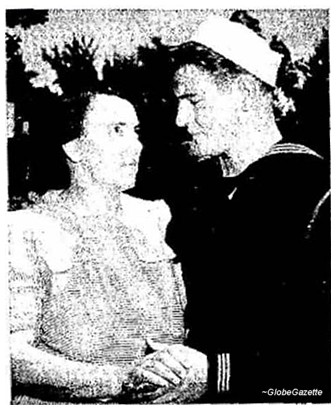


Cerro Gordo County Iowa
Part of the IaGenWeb Project
|
The Globe Gazette Mason City, Cerro Gordo County, Iowa Saturday, May 9, 1942, Page 8
EPIC "MARBLEHEAD" TRIP
He is Melvin O. WHITNEY, fireman first class, who wired his parents, Mr. and Earl M. WHITNEY, 539 Fourth street northeast, on Thursday: "Hello folks, I'm O.K." This was the first word his parents had received from him since Dec. 13, when they were sent a form card which did not designate its origin. The young Mason Cityan enlisted in the navy in January of 1941,a nd since May of 1041 - a year ago - has been on United States warships in the Pacific area. WHITNEY was one of the brave crew which survived a battle with the Japs as they advanced southward through Macassar strait in their invasion of the Dutch Indies. The Marblehead was "bombed to hell," as the navy put it, but not only kept afloat, but limped 13,000 miles to a home port.
The Globe Gazette

Crew Bailed for 72 Hours to Avert Loss
 (Lock photo, Kayenay engraving.) Home looked good to Melvin Whitney, of the U. S. army, who arrived in Mason City Thursday on leave. Whitney was one of the crew of the U. S. light cruiser Marblehead, which limped home 13,000 miles after being badly disabled in the battle of Macassar Straits. The return trip lasted from February to May, three action-filled months of which will live in the memories of those who made it. Whitney doesn't say much about it, but he has a stirring story to tell of how crew members of the Marblehead bailed for 72 hours when water poured in from a leaking bulkhead so fast that the pumping equipment wasn't effective. Bucket brigades were formed which worked in shifts and managed to avert a swamping. On for three hours, off for three hours was the routine for three solid days. Whitney was a fireman first class on the Marblehead, sent to intercept a Jap convoy enroute to Macassar, when it was attacked by 54 Japanese planes Feb. 4. The planes spotted by another ship, which flashed a warning to the Marblehead, so that the crew members were able to be at their battle stations when the attack began. "It was pretty bad at first," Whitney said, "but we were too busy to think about being afraid. They attacked the biggest ships first - they didn't go for the small fry." During the three hours bombardment, gun crews of the Marblehead succeeded in knocking out three of the Japanese planes. The crippled Marblehead left the 10 other ships in the group, made for India, and in May finally reached a U.S. east coast port, after stopping at an African port to take on supplies. Since arriving in the United States, Whitney, with three other crew members and an officer of the Marblehead, has been making a nation-wide tour during which they addressed workers in war plants making navy equipment. Others in the group were Charles P. Cavanaugh of Casey, Iowa; Cornelius DeVries, Orange City; Robert H. Healey of Chicago, and Lieut. Com. Ralph G. Gillette of Savons, N. Y. The tour wound up in Chicago Wednesday. Whitney enlisted in the navy in January of 1941 and for more than a year had been stationed on U. S. warships in the Pacific.
NOTE: During the Battle of Macassar Straits (February 4, 1942 in Bali Sea, Dutch East Indies), USS Marblehead (CL-12)
joined other American ships and those of the Royal Netherlands Navy and Royal Australian Navy to patrol the waters of the
Dutch East Indies. The Marblehead was successful in maneuvering through three attacks, however a fourth wave of seven
bombers bombed her, two being direct hits and a third being a near-miss causing severe underwater damage to the cruiser. Although her
rudder was jammed and fires swept through the cruiser, she continued at full speed, circling to port while her gunners
continued firing. She sailed, looking for a port where she could be repaired. On March 24 she arrived at Simonstown, South
Africa, where she received extensive repairs. She set out for America on April 15, arriving in New York on May 4th and was
immediately placed in drydock at Brooklyn Navy Yard. Her journey consisted of over 16,000 miles after she was bombed. Extensive
repairs allowed The Marblehead to return to sea, attached to the South Atlantic Force and saw action during the staging of
Operation Dragoon, the invasion of South France. She was decommissioned on November 1, 1945, struck from the Naval Vessel
Register on November 28th, and her hulk was scrapped February 27, 1946. During World War II The Marblehead
received two battle stars.
Transcriptions and note by Sharon R. Becker, April of 2013
|
Return to Military Index Page Return to Cerro Gordo Home Page